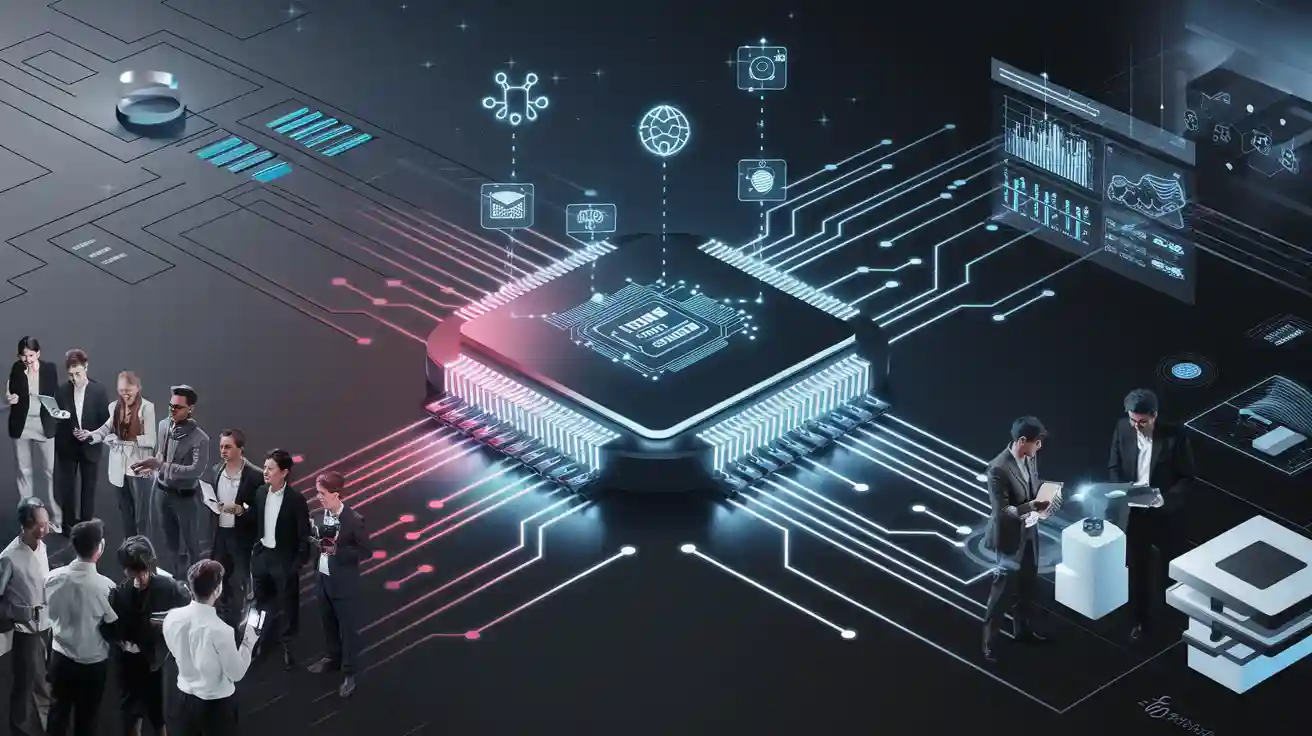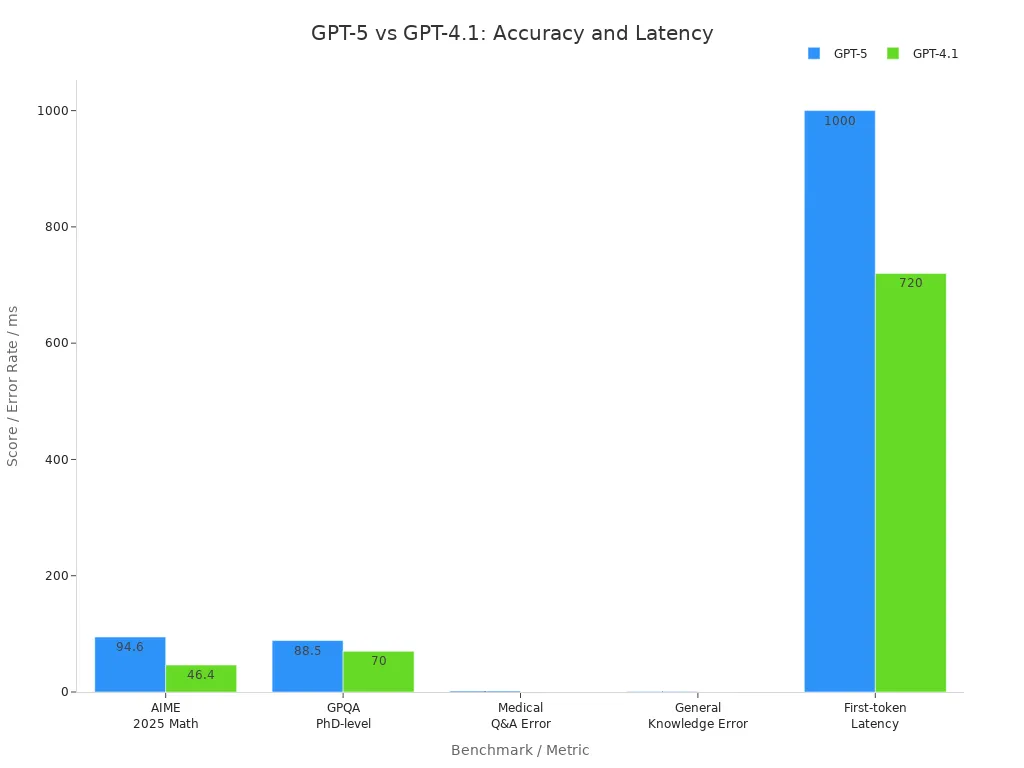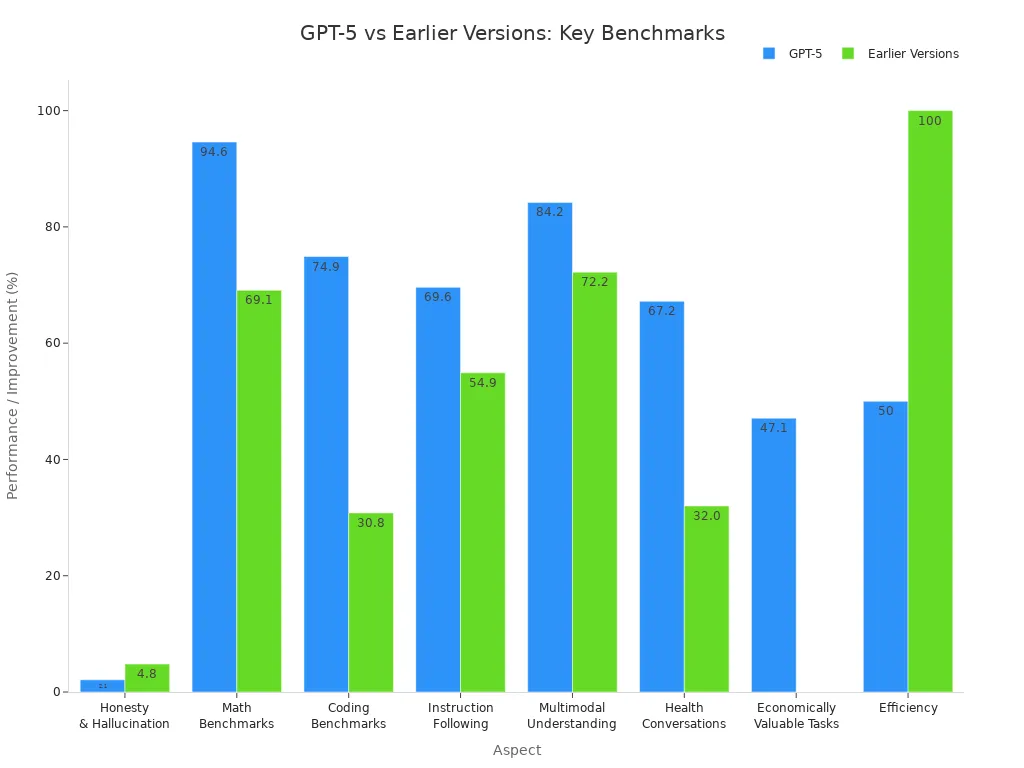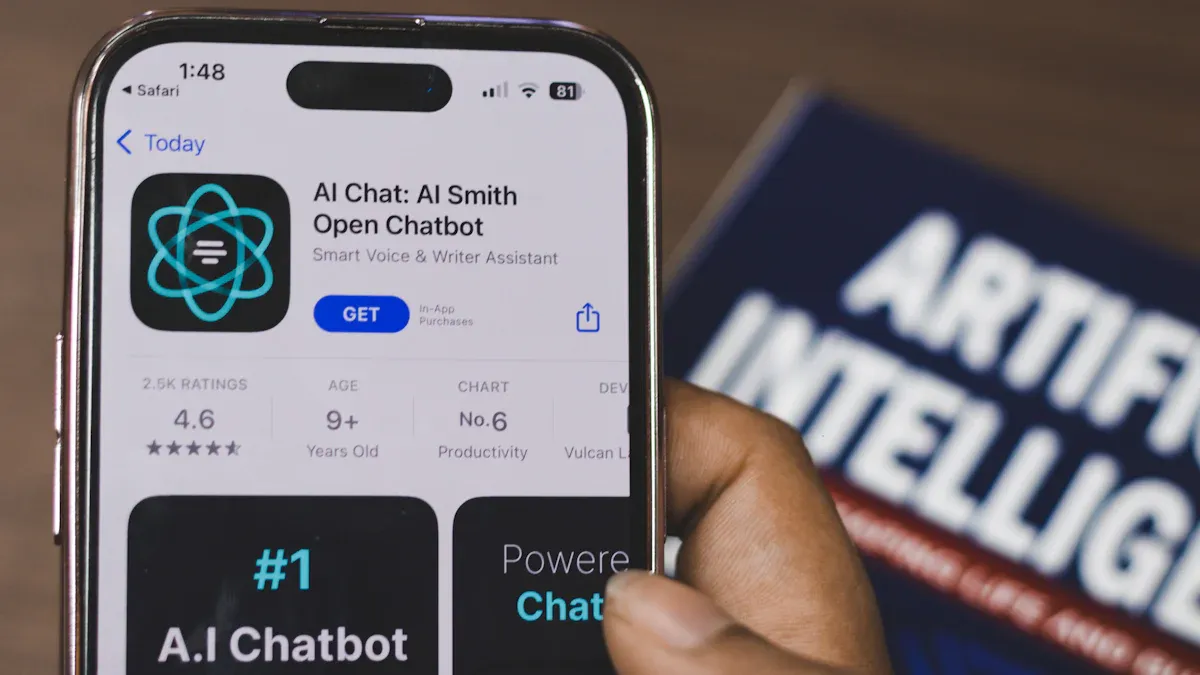GPT-5’s Reception: What Matters Most to Users and Experts

The newest gpt 5 update has started a big discussion in the AI world. Many people thought gpt-5 would be smarter, quicker, and understand more than older versions. But when openai released chatgpt and gpt 5, user happiness dropped a lot, as shown in new surveys.
Users say gpt-5’s answers seem too basic, and companies must edit more. Experts point out that hallucinations still happen and reasoning is worse.
Aspect | Key Observations |
|---|---|
User Satisfaction | gpt 5’s rating went down from 75% to 14% after the update |
Performance | gpt-5 did worse than gpt-4.5 on tests |
Experience | chatgpt users say there are fewer model choices and less context |
Even with these problems, gpt 5’s new router-based design and more tool options could help make better products and improve how people work in the future.
Key Takeaways
GPT-5 gives answers faster and smarter. It is better at coding and solving problems. This helps people use it for real jobs and apps. Users see that GPT-5 sounds more formal and gives shorter answers. They miss the friendly way older versions talked. This changes how they feel about using it. Experts like that GPT-5 is more correct and safer. But they say companies should have strong rules and people to check its work. GPT-5 is made to save energy and money. It uses different models for easy and hard jobs. This helps businesses work better. Developers can add GPT-5 to apps with tools like Momen. They can start small and test it to get the best results.
What Matters Most in GPT-5
Key Improvements
GPT-5 brings many new features that make it different from older versions. OpenAI made this update because people want smarter and faster AI. The new design uses a hybrid multi-model system. This system sends tasks to the right model based on how hard they are. Simple questions get fast answers. Harder questions get more careful thinking. Now, users do not have to pick different models for each job. This makes work easier and helps everyone have a better experience.
Aspect | Highlights |
|---|---|
Architecture | Hybrid multi-model routing for speed and reasoning depth |
Speed & Efficiency | Faster responses and improved multitasking |
Reasoning & Problem Solving | State-of-the-art performance in coding, math, and complex scenarios |
Tool Integration | Advanced, agent-like use of tools with parallel calling and better recovery from failures |
Accuracy | Up to 80% fewer factual errors in complex scenarios compared to earlier models |
Adaptive Modes | Auto, Fast, and Thinking modes for customizable verbosity and reasoning depth |
GPT-5 is very good at coding and solving problems. It gets higher scores than GPT-4o on tests. The model can handle hard coding jobs, like fixing tricky code issues and making apps in one try. GPT-5 uses tools by itself and does not need much help from users. It can use many tools at once and fix mistakes if something goes wrong. These things make GPT-5 helpful for developers and companies who want to use AI in their work.
OpenAI also added adaptive modes. These let users choose between speed and deep thinking. This helps with many tasks, like quick chats or long writing. Experts say GPT-5 writes better, is more creative, and can do many things at once. This makes it a great pick for smart apps.
User Concerns
Even with these upgrades, users have some worries about GPT-5. Many people think the answers are shorter and sound too formal. Some say the chat feels "cold" or "blunt" and miss the friendly style from GPT-4. When OpenAI first took away older models like GPT-4o, it made things harder for some users. This was a problem for chatgpt Plus subscribers. OpenAI brought back these models and added model pickers to help.
Users said GPT-5 did worse than GPT-4o at first because the new router system had problems.
Taking away old models without warning made people upset and hurt their experience.
Many users felt sad about the less friendly tone and said it felt like losing a friend.
The "chart crime" event, where wrong charts were shown, made people trust GPT-5 less.
OpenAI said sorry for the mistake, brought back GPT-4o for Plus users, and promised to keep making things better.
Some users said GPT-5 needs new ways to ask questions, which makes it harder to learn.
Even though tools and coding are better, people still worry about writing quality and if it stays the same for every task.
Both users and experts agree that GPT-5 has new features and big improvements. But the change has not been easy for everyone. The update changed the way it talks, how people work, and which models they can use. OpenAI is still working to fix these problems by making things more stable, open, and listening to feedback.
Expert Reviews of GPT-5
Performance Benchmarks
Experts looked at how well GPT-5 works on many tests. They saw that GPT-5 is very accurate and reliable. It almost doubled math scores from older models, getting 94.6% on the AIME 2025 Math Exam. On hard reasoning tests like the GPQA PhD-level test, GPT-5 scored about 89%. This is much better than older versions. For medical and general knowledge, error rates are now less than 2%. This makes GPT-5 more trusted for important jobs.
Benchmark / Metric | GPT-5 Performance | GPT-4.1 Performance | Notes / Interpretation |
|---|---|---|---|
AIME 2025 Math Exam Accuracy | 94.6% | 46.4% | GPT-5 nearly doubles GPT-4.1's score, showing major accuracy improvement in complex math reasoning. |
GPQA (PhD-level reasoning test) | ~88-89% | ~70% | GPT-5 shows superior reasoning ability on advanced scientific and logic problems. |
Medical Q&A Error Rate | 1.6% | Much higher (exact not specified) | GPT-5 has fewer hallucinations and factual errors, indicating better reliability. |
General Knowledge Error Rate | Under 1% | Much higher | GPT-5 is more accurate and less prone to misinformation. |
First-token Latency (Minimal Mode) | ~1000 ms | ~720 ms | GPT-5 is slower due to deeper reasoning, impacting real-time applications but negligible in casual use. |
Token Usage in Coding Tasks | 22% fewer tokens | Baseline (GPT-4.1-era) | GPT-5 is more efficient, producing more concise outputs. |
External Tool Calls in Coding | 45% fewer calls | Baseline (GPT-4.1-era) | GPT-5 wastes less time on unnecessary steps, improving efficiency. |
Context Window Size | Up to 400k tokens (API), 128k (ChatGPT Pro) | 16k tokens (ChatGPT GPT-4.1) | GPT-5 handles much larger contexts, improving long conversation and document handling. |

Experts say GPT-5 thinks deeper, but this makes it slower. The first answer takes about 30-40% longer than before. OpenAI’s new routing system helps balance speed and accuracy. Easy questions get fast answers from simple models. Harder tasks get more careful answers. This makes GPT-5 good for both quick chats and tough jobs.
When experts checked costs and resources, they saw GPT-5 is made to save energy. It uses both light and heavy models. A routing model picks the best one for each job. GPT-5 uses the MXFP4 data type, which cuts memory and computer needs by up to 75%. This means lower costs and better use of resources, especially for big companies.
Aspect | GPT-5 Details | Comparison to GPT-4o / Impact on Costs and Resources |
|---|---|---|
Model Architecture | Collection of models: lightweight LLM + heavier-duty model with routing model directing prompts. | Routing aims to reduce compute by serving most requests with less resource-intensive models. |
Data Type | Uses MXFP4 data type reducing memory, bandwidth, and compute by up to 75% compared to BF16. | Significant cost savings and resource efficiency over previous models including GPT-4o. |
Context Window | No increase for free or Plus users (8,000 tokens free, 128,000 tokens Plus/Pro). | Smaller context windows reduce memory and GPU requirements compared to larger contexts. |
API Context Window | Supports up to 400,000 tokens but at high inference cost (~$0.50 per fill). | Larger context available but expensive, balancing resource use and user needs. |
Model Deprecation and User Demand | GPT-4o was initially deprecated but restored due to popularity despite lower reasoning ability. | Indicates GPT-4o remains resource-intensive but valued; GPT-5 focuses more on cost-cutting. |
Overall Strategy | Emphasis on cost-cutting and resource optimization rather than major capability leaps. | Prioritizes efficient resource use and compute cost reduction over raw performance gains. |
Compute Fleet Expansion | OpenAI plans to double compute capacity in 5 months to improve resource availability. | Will help support increased API demand and maintain resource efficiency. |
Experts agree GPT-5 is a big step forward for AI. It is faster, smarter, and can handle more information than before. It is useful for real jobs like coding and working with documents.
Security and Efficiency
Security is a big worry for experts looking at GPT-5. Outside researchers found that GPT-5 does not do well on safety tests. They found problems like prompt injection, data poisoning, jailbreaking, and data leaks. These issues make GPT-5 risky for companies unless they add extra safety steps. Even though OpenAI and Microsoft say their safety is strong, outside testers found a gap between what is promised and what really happens.
Security Aspect | Implemented Features |
|---|---|
Authentication | JWT token with expiration, refresh token rotation, multi-factor authentication (TOTP), secure session cookies |
Data Protection | Input validation with parameterized queries, output encoding to prevent XSS, CSRF token validation, rate limiting |
Privacy Compliance | GDPR-compliant data handling, cookie consent management, data anonymization, user data export and deletion workflows |
Experts say companies should use strong rules and human checks with GPT-5. New safety features, like fewer hallucinations and safer answers, help with some risks. But companies still need to watch and adjust the model to fit their needs and follow laws.
Energy use is another big topic for experts. GPT-5 uses much more energy than older models, sometimes up to 20 times more than GPT-3. This is because the model is bigger and can do more things. New rules, like the EU AI Act and US FTC checks, push companies to show and lower AI energy use. Buyers and investors now want AI to be more open and green.
Experts suggest some ways to save energy and money:
Use smaller models for easy jobs.
Limit tokens and group requests to save computer power.
Pick vendors who care about energy use and reporting.
Test GPT-5 in small steps before using it everywhere.
Use caching and better workflows to cut costs.
Case studies show companies can cut energy costs by up to 42% with careful planning and hybrid models. Project managers should think about higher costs and environmental risks with GPT-5. Early users who track and share energy use can get better business deals.
GPT-5’s design and bigger context window help with coding, document work, and customer service. Microsoft uses GPT-5 in its business tools to help with rules and big projects. Experts say GPT-5 is not a full replacement for old models. Testing and careful planning are needed for success.
Experts say GPT-5 gives faster answers, thinks deeper, and uses tools better. Its new safety features and better reliability help companies, but good planning and rules are still very important.
User Feedback and ChatGPT-5 Reviews
First Impressions of GPT-5
Lots of people shared what they thought about gpt-5 online. Most noticed that gpt-5 answers much faster than other AI, even Claude. Users liked its coding skills and said it solves problems on the first try. It makes fewer mistakes and keeps code patterns the same. People said gpt-5 does not make many errors and is better at fixing things than older models. Some users saw small problems, like memory mistakes or old image issues. Most people think gpt-5 gives a smooth experience, especially for coding.
Early reviews say gpt-5 writes better and feels more polished than GPT-4o. Users think it has fewer hallucinations and is better for serious work. New things like "Personalities" and better memory help people make it their own, but some memory bugs are still there. Safety tools now block more bad or tricky answers. GPT-5 is not a huge change, but most reviews say it is clearly better.
Common Complaints
Even with these upgrades, people have some complaints about gpt-5:
Many say gpt-5 feels "cold," "robotic," or "soulless" and miss the friendly style from before.
Replies are shorter and more formal, so chatgpt is less fun.
People got upset when OpenAI took away old models like GPT-4o without warning, so some quit their subscriptions.
New message limits and a broken "autoswitcher" made gpt-5 seem less smart and flexible.
A big Reddit post complaining about gpt-5 got thousands of comments, with people calling it "horrible" and "the biggest piece of garbage even as a paid user."
CEO Sam Altman answered the complaints, saying GPT-4o would come back and gpt-5 would get better and have higher limits.
Many people miss the old chat style and picking different models. The formal tone and fewer messages are still big problems. Even with these issues, gpt-5 is faster, smarter, and understands more. It is still useful as a chatbot and helps build smart apps for real jobs.
GPT-5 vs Previous Versions

GPT-5 vs GPT-4o
Studies show gpt-5 works better than older models. GPT-5 does a better job at reasoning, coding, and being reliable. For example, GPT-5 gets 89.4% on hard science questions. GPT-4o only gets 70.1%. Coding tests show GPT-5 is strong. It scores 74.9% on SWE-bench and 88% on Aider Polyglot. GPT-5 makes fewer mistakes in medical questions. Its error rate is just 1.6%. GPT-4o makes more mistakes, with a rate of 15.8%. The new reasoning mode in gpt-5 lowers real-world errors from 11.6% to 4.8%. GPT-5 can handle bigger tasks with a context window up to 400,000 tokens. This helps with long jobs and tough workflows.
GPT-4o (Earlier Model) | GPT-5 (2025 Release) | |
|---|---|---|
Reasoning Capabilities | Limited in complex reasoning | Superior accuracy, chain-of-thought, multi-step logic |
Coding Performance | Weakest in coding benchmarks | Leading scores, autonomous coding, bug detection |
Hallucination/Error Rates | High error rates, especially in health | Very low hallucination rates, improved factual consistency |
Context Window | Up to 32K tokens | Up to 400K tokens (API) |
Efficiency | Resource-intensive | Improved efficiency, fewer tokens/tool calls |
Safety and Reliability | Moderate safety measures | Advanced safe completions, bias mitigation, transparency |
Use Cases | General multimodal applications | Industry-ready AI for healthcare, legal, coding, education |

Strengths and Weaknesses
Experts say gpt-5 has many strengths. It uses a special design with a router to think faster and deeper. GPT-5 is great at coding, math, and health tasks. New safety features help stop mistakes. These features cut hallucinations by 65% and big errors by eight times. GPT-5 can code by itself, which helps developers and companies.
People notice gpt-5 is more honest and clear. It says when it cannot do something, which helps people trust it. GPT-5 does more with less, making work faster for chatgpt users. Some people miss the friendly style from older models. They think the new style is too formal. GPT-5 is good at real jobs and is reliable. But some users wish it was more fun to talk to.
GPT-5 is a big step forward for AI. It is quicker, smarter, and understands more than older models. It helps with many jobs, not just chatgpt, and works well for different industries.
Adoption and Use Cases

Enterprise and Developer Adoption
OpenAI is seeing many big companies use GPT-5. Lots of businesses now pick GPT-5 for coding, planning, and hard jobs. Startups and well-known companies like Cursor, Vercel, Factory, JetBrains, Lovable, and Box use GPT-5 as their main model. They like that it works better, saves money, and fits in easily. OpenAI grew its sales team to over 500 people to help more companies use GPT-5.
Developers are excited about GPT-5’s coding and design tools. Big companies are now using GPT-5 for real work, not just tests. They say it helps them do coding and customer support two to five times faster. GPT-5 works well with Microsoft tools and has new ways to fine-tune, so it is easier to start using. Its simple interface and smart task system make it less confusing, so more people can use advanced AI.
GPT-5’s smart thinking and money-saving features make more people use it, even though some users are still getting used to the new style.
Ideal Applications
Companies and developers use GPT-5 for many real jobs. It is great for things like entering data, making documents, automating tasks, and organizing content. Many businesses use GPT-5 to create content, translate languages, and run chatbots for customer service. Spotify and Duolingo use GPT-5 to help with many languages. Others use it to find information and improve how they get answers.
GPT-5 is very good at coding. It helps beginners and experts write code, explain ideas, and fix problems. In media, it helps with sorting images, writing down speech, and translating talking. Healthcare, finance, and legal teams use it because it is accurate and can handle big files.
Application Area | Example Use Cases |
|---|---|
Coding | Automated code writing, debugging, algorithm design |
Content Creation | Blog posts, social media, translation |
Customer Service | Multilingual chatbots, personalized responses |
Workflow Automation | Data entry, document management, process control |
Healthcare & Finance | Medical imaging, fraud detection, compliance |
GPT-5’s strong training and big context window help with hard analysis, mixing different types of data, and agentic AI. It does better than old models in thinking, coding, and important safety jobs. This makes it the best pick for companies that want smarter, faster, and more trustworthy AI.
Integrate GPT-5 in Your App
It is now easier to use GPT-5 in real apps because of platforms like Momen. Momen’s AI Agent Builder lets teams use GPT-5’s strong reasoning, speed, and context skills without needing to code a lot. People can just say what they want in plain language, and the system makes code or sets up tasks for them. This helps teams build test versions, first products, and business tools quickly.
Key features of Momen’s AI Agent Builder include:
Retrieval-Augmented Generation (RAG) gives smarter answers with more details.
It uses tools and makes organized results for better automation.
You can connect it easily with other models and data sources.
It links to user interfaces fast, especially when used with Lovable for design.
Tip: Teams can add features or change tasks with simple steps, so updates are quick and easy.
Developers like GPT-5’s modular setup. They use it to make questions clearer, give long answers, and break work into steps. Momen’s platform has safety rules, like sorting tasks by intent and watching things live, to keep things safe and follow rules. Openai says to start small, test with pilot projects, and grow as teams learn more.
Best practices for integrating GPT-5:
Start with a small project that has clear goals.
Teach teams how to write good prompts and work with AI.
Use roles and logs to keep things safe.
Keep testing and fixing the system to make it work well.
Challenge | Solution with Momen & GPT-5 |
|---|---|
State management | Organized tasks and memory |
Modular setup, clear instructions | |
Business logic gaps | People check and improve prompts |
Debugging | Live tools to watch and fix issues |
Openai’s new tests show GPT-5 is 23% more accurate and 40% faster than older models. But developers should still watch for rare problems and have backup plans for important jobs.
Momen and GPT-5 help companies make smart, big apps that do more than just chat. Teams can automate tasks, give better customer help, and build smarter products with less work. Anyone who wants to try these tools can start building with GPT-5 and Momen now.
GPT-5 has new technical features and does well on tests. But many users feel upset about how it works and changes to which models they can use. Experts see that GPT-5 helps with coding, healthcare, and learning. They say its reasoning and multimodal skills are better now. Companies like that GPT-5 is easy to add to their work and helps them get more done. This is true when they use platforms like Momen. People using GPT-5 will notice smarter ways to work and quicker results. Still, people need to check what GPT-5 does to make sure it is right.
Teams trying out GPT-5 can use prompt engineering, new settings, and multimodal skills to make smart and useful apps for real jobs.
FAQ
What makes GPT-5 different from earlier models?
GPT-5 uses a hybrid multi-model system. It gives answers faster than before. It can solve harder problems and understands more details. Companies use it to make smarter apps, not just chatbots. This upgrade helps teams work better and finish tasks quickly.
Can GPT-5 help with real business tasks?
Yes, GPT-5 can help with many jobs. It automates coding, document work, and customer support. Many companies use it to make work faster and more accurate. Its smart reasoning and tool use make it good for real jobs.
Is GPT-5 safe for enterprise use?
GPT-5 has new safety features and makes fewer mistakes. Experts say companies should add human checks and strong rules. Companies need to test it first and watch results to keep data safe.
How does GPT-5 handle large projects or long documents?
GPT-5 can handle up to 400,000 tokens in the API. It can manage long talks and big files. This helps teams look at, sum up, and automate hard tasks easily.
Who benefits most from using GPT-5?
Developers, businesses, and teams who want smart automation benefit most. GPT-5 helps people get more done and make fewer mistakes. It works well for coding, making content, and helping customers.
See Also
Key Insights For Building Your Startup's MVP In 2025
Comparing DeepSeek V3 And GPT-4o LLM Models In 2025
Comprehensive Guide To Developing MVPs Successfully In 2025
13 Effective Methods To Utilize Chat GPT For Business Growth
Stepwise Launch Strategy Behind Momen's Product Hunt Victory

